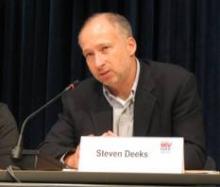WASHINGTON – The International AIDS Society has officially shifted its focus from controlling to curing HIV infection.
Their seven-point plan called "The Inaugural Global Scientific Strategy Towards an HIV Cure" will be published online July 20 in the August issue of Nature Reviews/Immunology (vol. 12, pp. 607-14), and is outlined in a commentary published in Nature (vol. 487, pp. 293-4).
The strategy merely represents the first step toward finding an AIDS cure, Dr. Steven Deeks emphasized at a press conference announcing the strategy. "No one thinks it’s going to be easy. Many people don’t even think it’s going to be possible. But, it’s certainly worth the investment."
"[Antiretroviral] drugs control the virus; they don’t eliminate it. In 2012, we now have 20-25 drugs, [used in] multiple combinations. They work very well, and people are now living much, much longer. But now that we’ve achieved what I think is the best that we can achieve with these drugs, we’re realizing some limitations," said Dr. Deeks, professor of medicine at the University of California, San Francisco.
HIV therapy is limited by problems of adherence, toxicity, cost, and lack of infrastructure in many countries for delivering drugs, he said. "Delivering drugs to the 33 million HIV-infected individuals worldwide – day in, day out, for decades and decades – is going to be a major challenge. ... So, now that we’ve achieved what we can with the current strategies, the field has shifted to what we think is the optimal intervention, which is to come up with a safe, affordable scalable intervention that will essentially either eliminate the virus completely or modify the immune system so that it can control the virus in the absence of therapy – a cure."
Fueling optimism about the possibility of a cure is the so-called "Berlin Patient," a man named Timothy Brown who received bone marrow from a naturally HIV-resistant donor. The Berlin Patient is now off all drugs at 5 years post transplant and remains virus free. "I don’t think anyone would want to go through what he went through to get that cure, but [the process] proved it could be done. This has really, truly inspired the field," said Dr. Deeks, cochair of the 34-member scientific panel that developed the strategy.
The seven research priorities described in the strategy for the cure are as follows:
• Determine the cellular and viral mechanisms that maintain HIV persistence.
• Determine the tissue and cellular sources of persistent HIV in individuals on long-term antiretroviral therapy.
• Determine the origin of immune activation and inflammation in the presence of antiretroviral therapy and the consequences for HIV persistence.
• Determine host and immune mechanisms that control infection but allow viral persistence.
• Study, compare, and validate assays to measure persistent infection.
• Develop and test therapeutic agents or immunologic strategies to eliminate latent infection in individuals on antiretroviral therapy.
• Develop and test strategies to enhance the capacity of the host response to control viral replication.
The panel was convened by the International AIDS Society with endorsements from major HIV-related organizations and institutions worldwide including amfAR, UNAIDS, the University of Pennsylvania, the Fred Hutchinson Cancer Research Center, and Monash University. The National Institutes of Health has recently undertaken targeted funding initiatives, including the Martin Delaney Collaboratory, which provides grants for research on a cure for HIV infection.
Other groups also are increasing research funding for a cure, including the French National Agency for Research on AIDS and Viral Hepatitis, the Canadian Institutes of Health Research and the Medical Research Council in the United Kingdom. Moreover, many pharmaceutical companies that had invested heavily in developing antiretroviral drugs are now also allocating resources toward pursuing a cure, according to an International AIDS Society statement.
Dr. Deeks disclosed that he has received grant support from Merck and Gilead, and has consulted in the past for Bristol-Myers Squibb, Merck, GlaxoSmithKline, and Gilead.


